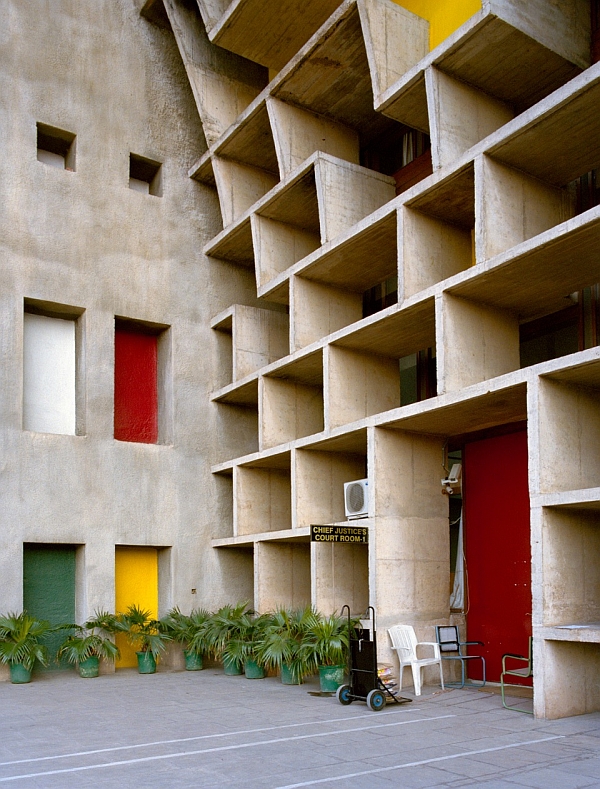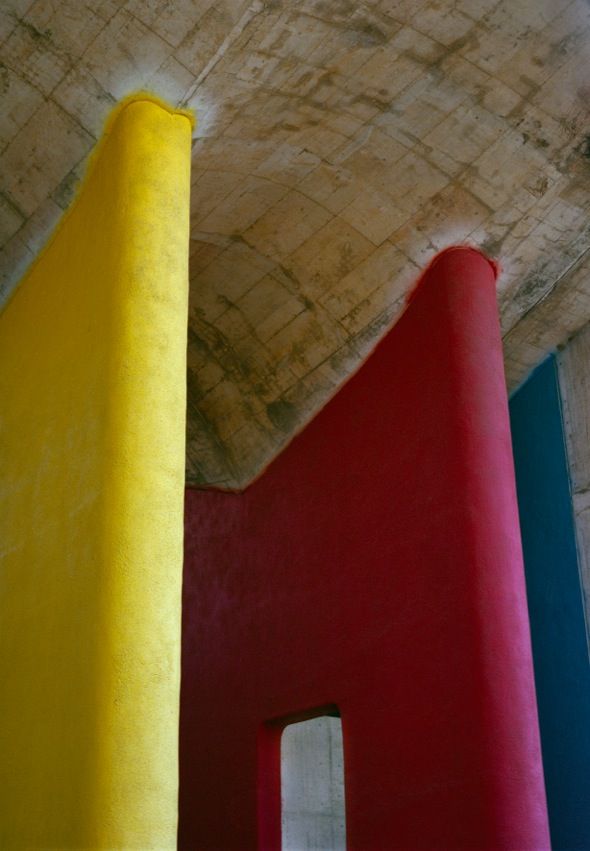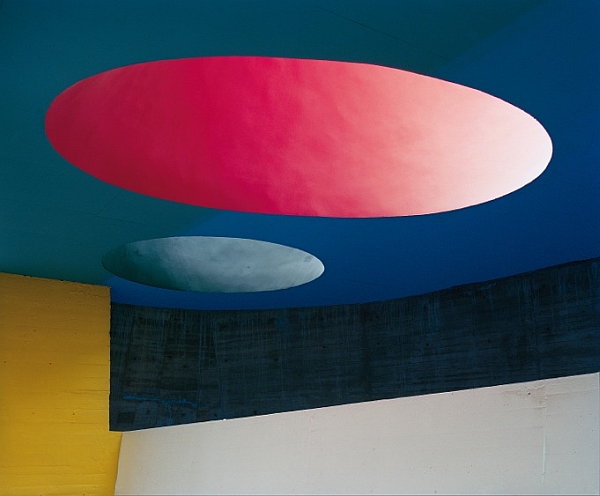Buildings are, somewhat logically, 3D. Photographs 2D. The challenge of architecture photography is transforming the 3D to 2D in such a way that the building maintains its identity without the photograph becoming incomprehensible.
Always has been. Always will be.
One of the younger generation of artists to accept the challenge is Leipzig based photographer Margret Hoppe. Born in Greiz, Thüringen, Margret Hoppe studied photography at the Hochschule für Grafik und Buchkunst Leipzig, graduating from Professor Christopher Muller's Meisterklasse, and is currently completing a PhD at the Hochschule für Gestaltung Offenbach in which she is exploring the relationship of architecture and photography based on the example of the French photographer Lucien Hervé. Whereas Margret Hoppe's work initially concentrated on the interiors of abandoned and disused buildings, her current focus is the buildings of the Swiss modernist architect and urban planner Le Corbusier. In addition to being presented in regular solo and group exhibitions Margret Hoppe's work has won numerous prizes including "gute aussichten" – junge deutsche fotografie, the Marion Ermer Preis and most recently the 2014 Kunstpreis der Sachsen Bank, and is included in the collections of an impressive roster of international museums. We first became aware of Margret Hoppe's work in context of the 2013 International Marianne Brandt Contest where her "Aprés une architecture" series was nominated. Presenting images of the interiors of Le Corbusier's buildings we were instantly taken by the intensity and lightness of the work and the unpretentious manner in which the photos opened up new aspects of the Le Corbusier canon while remaining familiar and accessible. Keen to find out more about the artist and her work we met up with Margret Hoppe to discuss Le Corbusier, photographing Le Corbusier's works and architecture photography in general, but started by asking why photography?
Margret Hoppe: As a child I always wanted to study art, specifically painting, but then when I was 14 I was given my first camera. Together with my brother we had a small dark room where we developed our own photos and for me the initial fascination was the technical aspects of photography, and the fact that in comparison to painting photography is a very instantaneous art form, and so as a consequence I decided to study photography.
smow blog: If you had a dark room at home, does that mean your family was involved professionally with photography, or......?
Margret Hoppe: No not all. The dark room was something that was quite typical in the DDR, many families had small darkrooms for developing their own photographs. In those days it was invariably black and white photography and so it wasn't that complicated once you knew what to do and was also relatively cheap.
smow blog: A central feature of your portfolio is abandoned buildings, what for you is the appeal of empty buildings as a subject?
Margret Hoppe: I think it is partly a reflection of the age I grew up in, of my generation. During the DDR years the region I grew up in was home to a large textile industry, an industry which collapsed following the end of the DDR and consequently I found myself surrounded by empty buildings and industrial ruins. I've always been fascinated by architecture and space and felt that with the camera I could somehow preserve those buildings who through industrial decline had lost their soul and function, and so I started photographing buildings in my immediate vicinity, and then when I moved to Leipzig I continued that work through my studies and also expanded my focus to include other considerations on abandoned buildings and what changes when a building is no longer required.
smow blog: Do you research the buildings in advance or do you try to approach them with an open mind, untroubled as it were by their past?
Margret Hoppe: The background to the building is very important. I generally try to choose buildings that were significant, such as the former guest-house for the DDR Council of Ministers in Leipzig which was a really representative political building in the DDR, or in my home town there is a former shoe factory which used to be a major employer and thus had an important economic and social function for the community. Often when you enter the buildings they initially appear chaotic, but I always try to photograph them as a coherent composition so that the viewer can make sense of the building and understand that it's not just a ruin, it's a building that served a specific function and had a real relevance. Ultimately as a photographer you can influence appreciation for and understanding of architecture.
smow blog: And how does one then progress from photographing abandoned buildings in East Germany to photographing works by Le Corbusier? Was that a deliberate decision or more an organic development?
Margret Hoppe: After I had finished my Meisterschule in Leipzig I was awarded a stipendium which allowed me to spend eight months at the Cité Internationale des Arts in Paris, and one day I visited a building by Le Corbusier and realised that although Le Corbusier is a big name in international architecture he is somehow so big that he stands in his own shadow: everyone knows the name Le Corbusier but not that many people have ever actually visited one of his buildings. At around the same time I discovered the work of Lucien Hervé, a French photographer who photographed Le Corbusier's complete oeuvre, and Hervé's photographs caused me to re-evaluate Le Corbusier's work and subsequently inspired me to photograph them. And in a way there is also a correlation between the modernism of Le Corbusier and East German construction, towns such as, for example, Eisenhüttenstadt in East Germany were planned cities, an aspect of urban planning which greatly interested Le Corbusier. So there is a little bit of continuity.....
smow blog: ...........albeit that in contrast to your DDR photos your photos of Le Corbusier's work tend to concentrate on details rather the complete building or whole rooms, why this concentration?
Margret Hoppe: While Le Corbusier's buildings themselves are without question interesting, I decided it would be more interesting to focus on the details as a way to explain the complete construction. All architecture is ultimately a question of perspective, and in Le Corbusier's works there are so many interesting perspectives which can help one understand Le Corbusier's intention and ideas, one just has to find them. And from an artistic perspective, in the interiors of Le Corbusier's works there are a lot of details which when photographed are more reminiscent of abstract paintings or sculptures than architecture and I wanted to depict these details as representative elements which stand as symbols of the complete construction.
smow blog: You mentioned earlier that photographers influence appreciation of architecture, and sorry but we have to ask, we're not big fans of contemporary commercial architecture photography, consider that lot of it is very obvious and generic, what is your opinion on contemporary architecture photography?
Margret Hoppe: I don't think you can generalise, largely because there is currently so much architectural photography and so, yes, naturally there is some very bad architecture photography and an awful lot of average, stylised, work but there is also some truly excellent architecture photography. Architecture photography is necessary, both for architects and photographers, and there will always be some photographers who are better than others. I also undertake commissioned work and I always try to do so in my own way and to find my own interpretation of the building and I think that is the important aspect, that as a photographer you don't just follow standards and stereotypes.
smow blog: And for the future are you planning to stay with architecture photography or can you envisage yourself moving on to new subjects and themes?
Margret Hoppe: I am certainly planning staying with architecture photography for the time being, but I think the aesthetics might change, I can imagine that over time I will make changes in the formal aspects of how I photograph, maybe move away from classic photography and into other genres, however I really want to stay with architecture photography because there are so many wonderful works and so many exciting possibilities.
More information on Margret Hoppe and her work can be found at www.margrethoppe.com, and for all in or near Lyon works by Margret Hoppe can be viewed as part of the exhibition "Passage (Lyon/Leipzig)" running at La Capitainerie, 41, quai Rambaud, 69002 Lyon until September 27th


